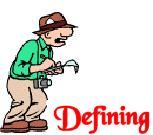 |
The student begins to identify information needs and how these might be satisfied.
The student
- is keen to explore and discover the world around them and make connections between what is known and what is yet to be discovered.
- identifies the main idea of class or group discussions about familiar topics
- listens to, understands and participates in class or group discussions on a given topic in response to an audio and/or visual stimulus
- participates in class or group discussions with relevant and appropriate contributions based on personal experiences and prior knowledge using appropriate and relevant
- vocabulary including some topic-specific words and phrases
- voice levels
- articulation
- body language and gestures
- eye contact
- uses prior knowledge and experiences to brainstorm ideas and vocabulary to contribute to a group list of what is already known.
- understands that while we may know some things, there is always more to learn.
- understands that some of the things we believe to be true may need further investigation.
- clearly expresses their need for information and seeks appropriate assistance to fulfil this.
- understands the difference between a question and a statement.
- understands that asking questions is a natural and effective way of eliciting information and has the confidence to ask these.
- asks and answers simple questions relevant to topic being discussed or examined.
- can pose questions that will lead to further investigation of people, places, objects and events
- can sort questions into categories to make investigations more focused
- uses modeled examples, and existing and new knowledge to generate questions to provide a focus for further investigation of a topic.
- expresses own ideas about why things are so and gives reasons which explain this understanding.
- can work with peers to suggest an appropriate solution to a problem.
|
 |
The student begins to locate a variety of primary and secondary sources which meet their information needs, using their knowledge of the purpose of texts and the library’s organisational system
The student
- understands that information can come from a variety of sources, each has a particular purpose and can suggest appropriate sources that might meet a particular need.
- uses own experiences and other people as information sources
- observes, listens and uses other senses to gin information
- understands that print, visual and digital texts can all provide information
- knows the difference between fiction and non-fiction – that fiction is for the imagination and non-fiction for information
- understands the relationship between text and illustrations in both fiction and non fiction resources
- identifies keywords in focus questions and uses these to contribute to a teacher-led search plan to locate appropriate resources.
- recognises environmental print such as signs, labels and instructions
- understands and uses the terms title, author, illustrator, subject, spine, spine label, blurb
- knows the layout of the library, especially those sections relevant to their needs and can locate required resources with assistance.
- uses the cover, title, and illustrations to select appropriate resources.
- can browse and select resources that meet interests, needs and abilities.
- understands fiction resources are shelved in a alphabetical order according to the surname of the author.
- understands non-fiction resources are shelved in numerical order according to their subject.
- understands that certain texts (digital or print), such as encyclopedias, atlases and dictionaries each have a specific purpose and layout.
- knows how to borrow and return resources
- demonstrates responsibility for borrowed resources
- identifies and uses Library Inquiry icon on computer desktop to undertake a simple search and returns computer screen to default position
- understands basic information provided by Library Inquiry search results
- locates identified resources with assistance
- uses mouse to open software programs or pre-selected websites, select appropriate navigation options, follow instructions, make choices and close program
- recognises and uses common icons used in software packages and pre-selected Internet sites.
- follows instructions to locate resources.
- constructs and sends simple email to a known person to elicit information.
|
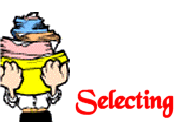 |
The student begins to select and record the appropriate information which meets their information needs.
The student
- listens, observes and views to gain information in response to focus questions.
- extracts information from objects and pictures and can talk about what has been discovered
- distinguishes between informative text and advertisements and other eye-candy, particularly on websites
- uses developing reading skills and strategies to extract information from simple texts about familiar subjects.
- understands the purpose of the contents, page numbers, headings and index of a resource and can use these to locate and select specific information.
- follows instructions to select specific information in pre-selected print or digital resources.
- selects and records the main idea and key words from a text or audio and/or visual source using a template or other example.
- interprets simple diagrams, including maps and graphs, which support key information.
- constructs an oral or written sentence about a topic using selected keywords
- justifies selection or rejection of information.
- understands that fiction can also provide information
- suggests simple cause and effect relationships by examining objects and pictures
- attributes the source of the information using title/ author format.
|
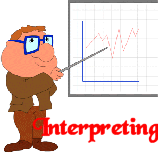 |
The student begins to understand that texts have different purposes
The student
- understands the difference between fiction and non fiction
- understands the difference between fact and opinion and make-believe
- begins to form their own point of view by drawing conclusions based on information at hand
- begins to identify the author’s purpose for writing – to persuade, inform, entertain or reflect
- begins to understand that the role a person has in an event influences their perception and retelling of it
- differentiates between first and third-person recounts
|
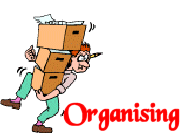 |
The student begins to understand the need for information to be organised so that it can be easily retrieved, manipulated and used.
The student
- participates in teacher-directed groups to consider the appropriateness, organisation and presentation of the information gathered.
- organises oral, pictorial and written information in sequence
- retells experiences, stories or procedures in sequence
- follows and/or gives simple instructions in sequence.
- sorts objects, pictures and ideas into specific categories using given or self-generated criteria and explains reasoning underpinning the groups.
- suggests simple headings for groups of related ideas or objects.
- understands the purpose of labels and signs
- compares and contrasts objects and pictures and recognises similarities and differences
- begins to identify patterns and relationships between ideas with assistance
- understands concepts of main heading and keywords.
- constructs a concept map, sequence or list to show the relationship of the ideas to each other and the focus question with assistance.
- constructs a table in MS Word (or similar) and assigns a bold heading to each cell.
- uses MS Paint (or similar) to create a story map to support a retelling.
- can highlight selected information and drag and drop or cut–and-paste it into the appropriate cell of a table.
- understands the purpose of graphs and contributes to a class or group pictograph which illustrates findings
|
 |
The student presents an appropriate oral, written, pictorial or role-play response to a task or question.
The student
- is willing to share information with other children and adults and has the confidence to do so.
- is aware that responses can be in a variety of formats and some are more appropriate than others at times
- understands the different purposes of writing and drawing
- creates a response to a task/ topic which meets the needs of the task and uses information selected for the purpose.
- dictates, traces, copies or writes captions to accompany presentations
- presents a response to the task in a simple oral, visual, or written sequence which demonstrates learning and understanding.
- presents a response to the task which demonstrates that the selected information has been synthesised and used to create a new product.
- demonstrates and describes how their response meets the needs of the task and how it was constructed.
- uses appropriate, relevant and effective conventions of speech such as staying on topic, intonation and volume, when responding to questions
- participates in a class construction of a rubric which describes the required elements of a particular presentation format.
- incorporates specific design elements or criteria required by the task.
- is willing to work with others and contributes appropriately to a range of group presentations including role-plays, constructions, stories and illustrations
- participates in group and class presentations with confidence and competence and observes conventions such as taking turns, waiting quietly and so on
- uses appropriate software and apps to write captions, draw pictures, and create presentation to share
- uses a digital camera with supervision to illustrate a presentation
- presents information in own language as well as English if appropriate
- begins to understand the concept of ‘audience’ and the need to meet their needs
|
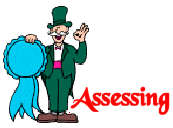 |
The student assesses the completed task to determine whether the original problem was solved and evaluates the effectiveness of their research.
The student
- demonstrates pride in the finished product
- is prepared to accept external praise and criticism of their work
- discusses work giving simple reasons for choices made
- completes tasks in a reasonable time
- persists to complete tasks to required standard or higher
- understands that there is always room for improvement and is prepared to work towards this
- understands the concept of a simple rubric and uses this to ensure that all parts of a task were completed to the best of their ability
- identifies those elements which were done well.
- identifies those elements which need support in the future and uses positive language to describe them
- develops concept of peer evaluation by giving and receiving feedback.
- accepts proportionate responsibility for group presentations.
- respects the efforts and contributions of others.
- acknowledges and celebrates personal and group achievements.
- shares feedback with parents
|
 |
The student reflects on their learning and how their knowledge, understandings and values have changed.
The student
- demonstrates and discusses what has been learned.
- transfers new knowledge, understandings and skills to different situations.
- uses what has been learned as a springboard for further learning.
- values what has been learned as an integral part of their making sense of the world.
- contributes to a class reflections session about what has been learned.
- reflects on their learning and records these reflections in a personal journal, print or digital.
|









